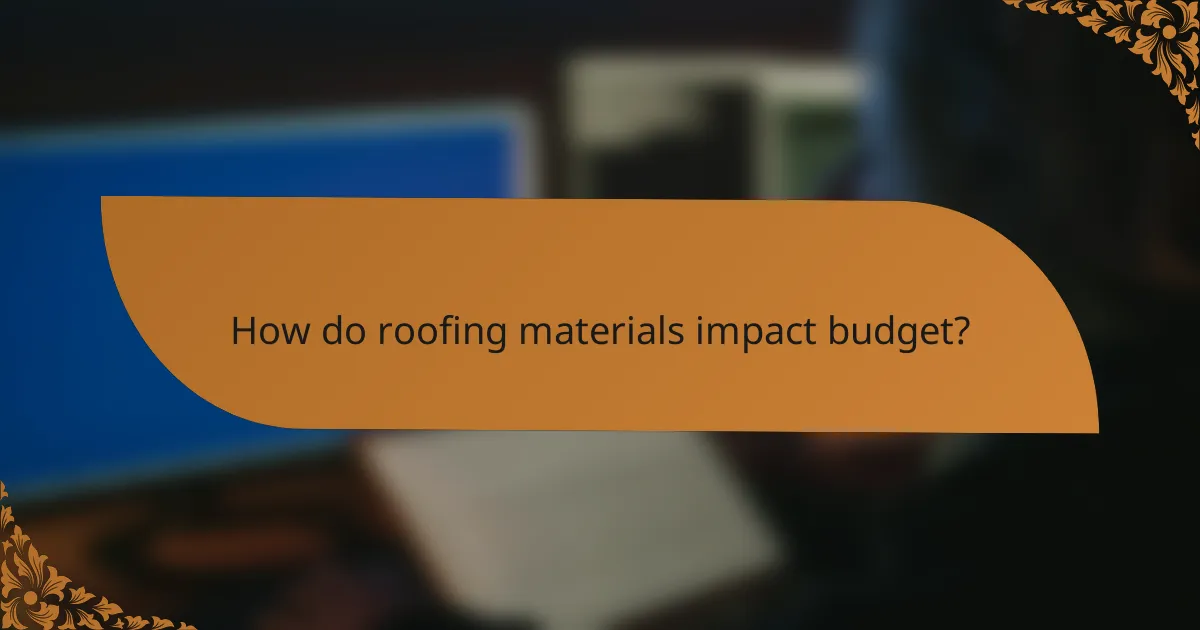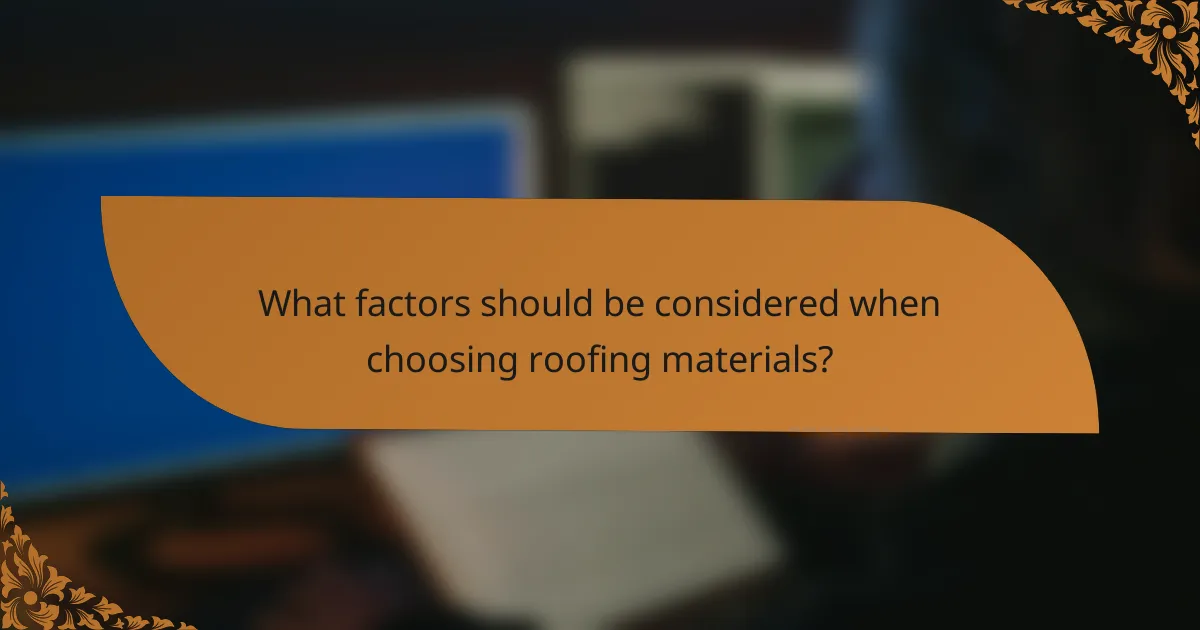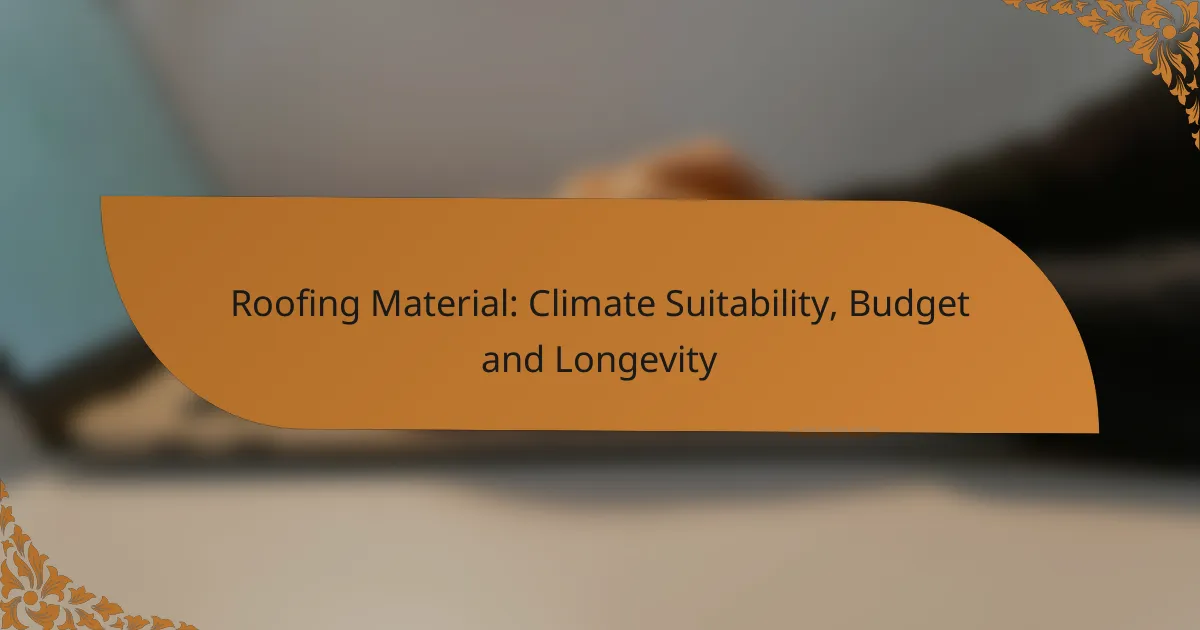When selecting roofing materials, it’s crucial to consider your local climate, as each option offers unique advantages and disadvantages that impact performance and durability. Additionally, the costs associated with different materials, including installation and longevity, play a significant role in your overall budget. By understanding these factors, homeowners can make informed choices that align with both their financial plans and environmental conditions.

What roofing materials are suitable for different climates?
Choosing the right roofing material depends significantly on the climate in which you live. Each material has its strengths and weaknesses, making it essential to match them with local weather conditions for optimal performance and longevity.
Asphalt shingles for temperate climates
Asphalt shingles are a popular choice in temperate climates due to their affordability and ease of installation. They perform well in moderate temperatures and can withstand seasonal changes, making them suitable for areas with both warm summers and cold winters.
When selecting asphalt shingles, consider the quality and warranty offered, as higher-end options can last longer, typically around 20 to 30 years. Ensure proper ventilation in your attic to prevent heat buildup, which can damage the shingles over time.
Metal roofing for hot climates
Metal roofing is ideal for hot climates as it reflects sunlight, reducing heat absorption and keeping homes cooler. This material is durable and can last 40 to 70 years, making it a long-term investment.
When installing metal roofing, ensure proper insulation and ventilation to maximize energy efficiency. Additionally, choose lighter colors to enhance reflectivity and minimize heat retention, which can be particularly beneficial in regions with high temperatures.
Slate tiles for cold climates
Slate tiles are well-suited for cold climates due to their natural durability and resistance to freezing temperatures. They can last over 100 years, making them one of the longest-lasting roofing materials available.
However, slate is heavy and requires a strong roof structure to support its weight. Ensure that your home’s framework is adequate before installation, and consider hiring a professional for proper placement and maintenance to prevent issues like cracking from ice expansion.
Clay tiles for humid climates
Clay tiles are an excellent choice for humid climates as they are resistant to mold and mildew, which can thrive in moist conditions. Their natural ventilation properties help keep homes cooler and drier.
While clay tiles can be more expensive upfront, they typically last 50 years or more. Ensure proper installation to avoid leaks and consider using a breathable underlayment to enhance moisture management. Regular inspections can help maintain their integrity over time.

How do roofing materials impact budget?
The choice of roofing materials significantly affects your overall budget due to varying costs, installation expenses, and longevity. Understanding these factors can help you make informed decisions that align with your financial plans.
Cost of asphalt shingles
Asphalt shingles are one of the most affordable roofing options, typically costing between $90 and $100 per square (100 square feet). Their low initial price makes them a popular choice for budget-conscious homeowners.
However, while they are economical upfront, asphalt shingles generally have a shorter lifespan of around 15 to 30 years, which may lead to higher long-term costs due to potential replacements.
Price range for metal roofing
Metal roofing generally falls within a mid-range budget, with prices varying from $300 to $700 per square. The cost depends on the type of metal used, such as steel, aluminum, or copper.
Metal roofs are known for their durability and longevity, often lasting 40 to 70 years, which can make them a cost-effective investment over time despite the higher initial price.
Investment in slate roofing
Slate roofing represents a premium option, with costs ranging from $600 to $1,500 per square. This material is highly valued for its aesthetic appeal and unmatched durability.
While the upfront investment is significant, slate roofs can last over 100 years, making them a wise choice for those looking for long-term value and minimal maintenance costs.
Budget considerations for clay tiles
Clay tiles typically cost between $800 and $1,200 per square, making them another high-end roofing option. Their unique appearance and durability are appealing, but they require a solid structural support due to their weight.
Clay roofs can last 50 years or more, which can justify the initial expense for homeowners who prioritize longevity and style in their roofing choices.

What is the longevity of various roofing materials?
The longevity of roofing materials varies significantly based on the type, with some lasting a few decades while others can endure for over a century. Understanding the lifespan of different roofing options helps homeowners make informed decisions based on their budget and climate conditions.
Asphalt shingles lifespan
Asphalt shingles typically last between 15 to 30 years, depending on the quality and installation. Standard three-tab shingles may have a shorter lifespan, while architectural shingles can offer better durability and warranty options.
When selecting asphalt shingles, consider local climate conditions. In areas with extreme weather, such as heavy rain or intense sun, investing in higher-quality shingles can enhance longevity and performance.
Metal roofing durability
Metal roofing can last 40 to 70 years, making it one of the more durable options available. Materials like steel, aluminum, and copper provide excellent resistance to weather elements, rust, and pests.
Choosing metal roofing can be a wise investment, especially in regions prone to severe weather. Proper installation and maintenance are crucial to maximizing its lifespan, so hiring experienced professionals is recommended.
Slate roofing longevity
Slate roofing is renowned for its exceptional longevity, often lasting over 100 years with proper care. Its natural stone composition makes it highly resistant to fire, rot, and insects.
While slate can be more expensive upfront, its durability can lead to lower long-term costs. Ensure that the structure can support the weight of slate, as it is significantly heavier than other roofing materials.
Clay tiles lifespan
Clay tiles generally have a lifespan of 50 to 100 years, depending on the quality and installation. They are highly durable and resistant to harsh weather conditions, making them suitable for various climates.
Clay tiles require minimal maintenance, but proper installation is essential to avoid issues like cracking. In regions with freeze-thaw cycles, ensure that the tiles are rated for such conditions to prevent damage over time.

What factors should be considered when choosing roofing materials?
When selecting roofing materials, consider climate, budget, and longevity. Each factor significantly influences the performance and cost-effectiveness of your roofing choice.
Climate impact on material choice
The climate in your area plays a crucial role in determining the best roofing materials. For instance, regions with heavy rainfall may benefit from materials like metal or asphalt shingles that effectively shed water, while areas with high temperatures might require reflective materials to reduce heat absorption.
Additionally, consider local weather patterns such as snow load, wind resistance, and UV exposure. Materials like slate or tile can withstand harsh conditions but may be heavier and require additional structural support.
Budget constraints
Your budget will significantly influence your roofing material selection. Asphalt shingles are often the most affordable option, while materials like slate or metal can be more expensive upfront but may offer better long-term value.
Factor in not only the initial cost of materials but also installation and maintenance expenses. It’s wise to obtain multiple quotes from contractors to ensure you’re getting a fair price for both materials and labor.
Longevity expectations
Different roofing materials have varying lifespans, which should be considered in your decision. Asphalt shingles typically last around 15 to 30 years, while metal roofs can last 40 to 70 years, and slate roofs can exceed 100 years with proper maintenance.
Choosing a longer-lasting material might require a higher initial investment but can save money over time due to reduced replacement and repair costs. Always check warranties offered by manufacturers, as they can provide insight into expected durability and performance.

How do local building codes affect roofing material selection?
Local building codes significantly influence roofing material selection by establishing minimum standards for safety, durability, and energy efficiency. These regulations vary by region, requiring homeowners and contractors to choose materials that comply with specific guidelines to ensure structural integrity and safety.
Building codes in California
In California, building codes are particularly stringent due to the state’s diverse climate and susceptibility to natural disasters like wildfires and earthquakes. The California Building Code (CBC) mandates specific requirements for roofing materials, including fire resistance ratings and energy efficiency standards.
For instance, roofing materials must comply with Class A fire ratings in wildfire-prone areas, which often means using non-combustible materials such as metal or tile. Additionally, energy efficiency regulations may require reflective roofing materials to reduce heat absorption, helping to lower cooling costs in hot climates.
Homeowners should consult local building departments to understand the specific codes applicable to their area. This ensures compliance and can help avoid costly fines or the need for rework if non-compliant materials are installed. Always consider hiring a licensed contractor familiar with local regulations to navigate these requirements effectively.
